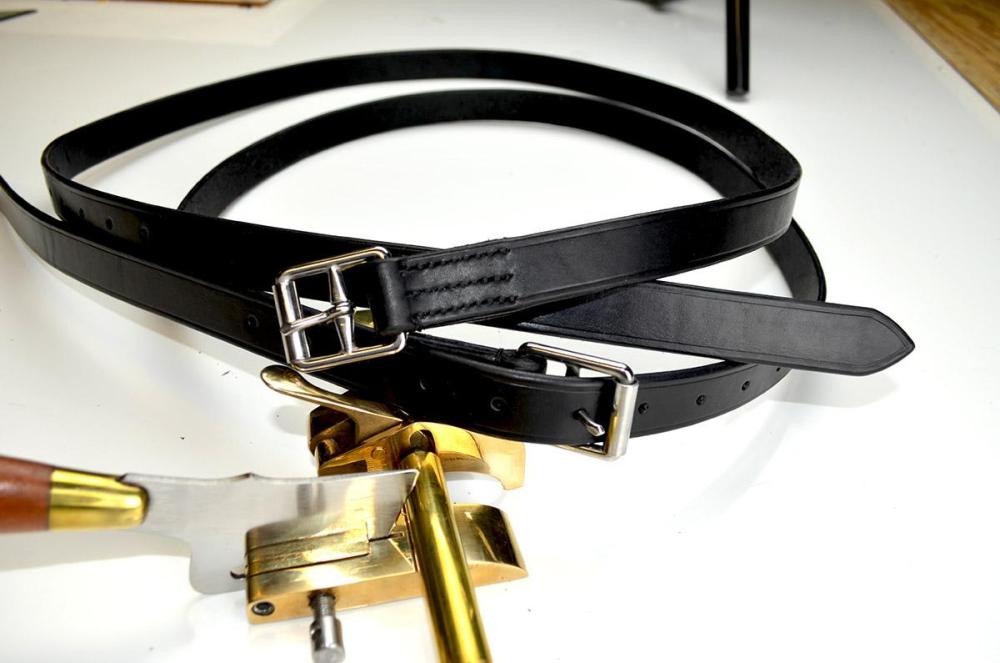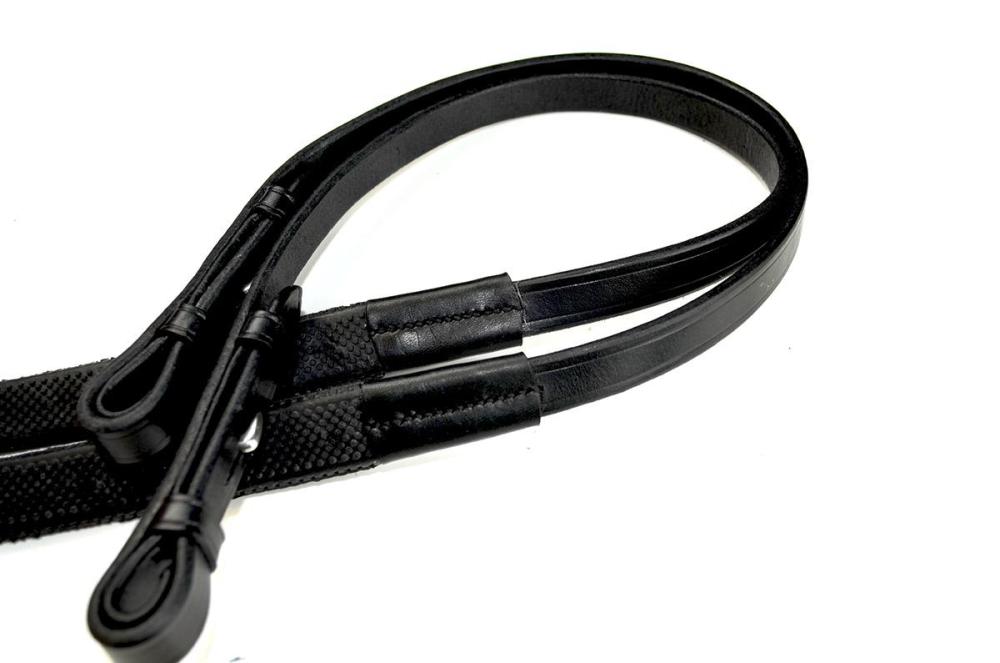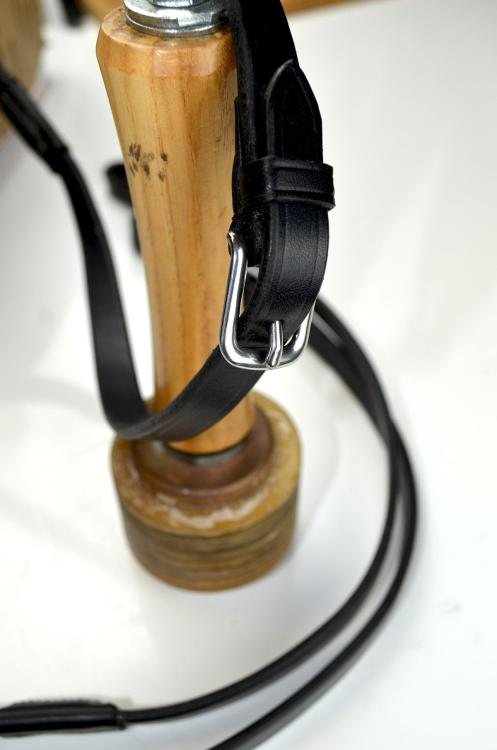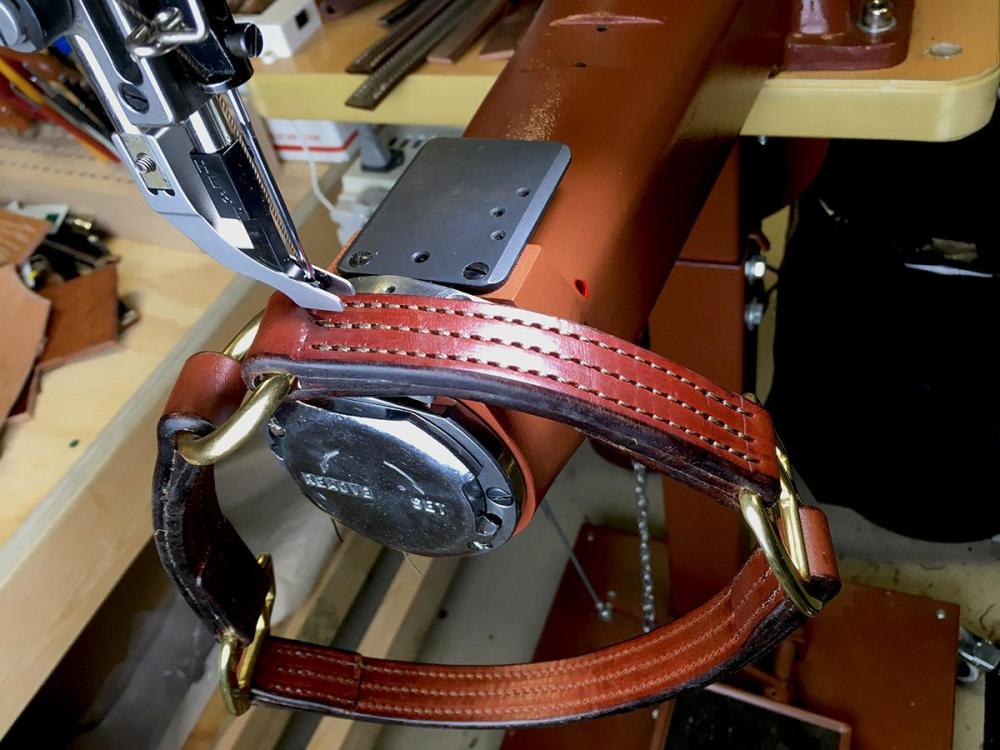-
Posts
1,282 -
Joined
-
Last visited
Content Type
Profiles
Forums
Events
Blogs
Gallery
Everything posted by TomE
-
Bridle and harness leathers are veg tanned and stuffed with oils and waxes to add finish and some water resistance. You still need to oil and condition the leather with use - as for maintaining horse tack. These leathers tend to be expensive and are correspondingly high quality tannage with a dense structure. I have been very happy with Hermann Oak bridle leather that I buy from Springfield Leather. You'll need a splitter if you need different weights for your project - in order to make everything from the same (dyed) hide. Springfield Leather can do custom cutting and splitting. Batz Corp has a number of aluminum clips similar to what I think you're describing. It's easiest to find their products in the catalog, which can be downloaded here https://www.batzusa.com/catalog-download/. I would call them for pricing and availability. Their website is hard to navigate.
-
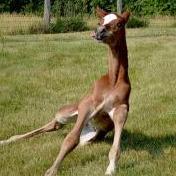
Still Buffing
TomE replied to Gosut's topic in Dyes, Antiques, Stains, Glues, Waxes, Finishes and Conditioners.
This video has some tips that were new to me for even dye coverage and eliminating rub off, particularly near the end of the video. Best of all, he says there are no firm rules and many ways to get a good result. -

Barrel saddle horn repair
TomE replied to 3arrows's topic in Saddle Identification, Restoration & Repair
A two part article on a braided rawhide saddle horn cover was published in the 2003 Mar/Apr issue https://leathercraftersjournal.com/product/2003-volume-13-no-2-mar-apr/ and the May/June issue https://leathercraftersjournal.com/product/2003-volume-13-no-3-may-june/ of the Leather Crafters and Saddlers Journal. Both back issues are available at their online store. See content descriptions at the links above. -
I wouldn't think so, but I would test how the CXL leather burnishes and blends with a backer strap. If the edge doesn't look right, you could use the horse hide as inlay for a veg tan belt.
-
I have exactly one #245 punch and it works great in 9-10 oz leather. Like all Osborne tools, it needed to be sharpened when new. I'll be buying more sizes of the #245, maybe as the #K-245 set of belt punches. I agree that the #147 punch looks like it has more taper and might be best for lightweight leather. I don't see the #145 punch on the current website https://www.csosborneleathertools.com/category/punches.
-
Although horse hide is denser/strongmer than cow hide, 5/6 oz might be a bit lightweight for straps/belts. If you use 2 layers you could make a raised leather belt. There's more information on these leathers at the Horween Leather Co website. My understanding is the Chromexcel tannage is pull-up leather. Is the football dimpled leather CXL tanned cow hide?
-

Still Buffing
TomE replied to Gosut's topic in Dyes, Antiques, Stains, Glues, Waxes, Finishes and Conditioners.
After lots of buffing, I would apply a light coat of neatsfoot oil, let it soak in for several hours to overnight, and buff some more. What weight leather are you working with and how did you apply the dye? -
Beautiful craftsmanship and LOTS of stitching. How are the bells attached to the strap?
-
Made a few things while working on a matching bridle. Pushing the envelope with black tack (dressage) instead of my usual brown (jumpers and hunters). HO bridle butt with hardware from Weaver (stud hooks, rein buckle) and Abbey England (stirrup buckles, rein grips). Oh, and I am finally on speaking terms with my plough gauge so I thought I'd show it.
-
Don't know what machine you're using, but I saw a suggestion for #92 thread in a 441-type machine: reverse the bobbin in the shuttle so the thread draws out the "wrong" way to increase friction and tension.
-
Since the pandemic/supply chain shutdown, I find it's best to call Batz Corp to check price and place orders. Most of their items are listed as "quote" which means they've been on back order. They are well stocked at present.
-
Great looking work with lots of character from the start. Would be fun to leaf through these at their 50 year anniversary, but that will be for someone else to do.
-
https://campbell-randall.com/product/fcf-317-fenice-colorfast-leather-dye-317-metallic-pearl-1-liter-1
-

sewing machine help Sewing machine for horse tack
TomE replied to mickeyw's topic in Leather Sewing Machines
Welcome. Hand sewing and using a machine are complementary skills and both are useful for making tack. I hand sew bridles and reins, and (mostly) machine sew halters. I do most repairs by hand sewing to reuse the original holes. You can gain a lot of experience with cutting, shaping, and finishing leather projects that you hand sew. A machine will greatly increase your productivity for some items. A lot of tack and holster makers use a TSC-441 type machine like the Cowboy 3200/4500 or Cobra Class 3/4. You can read in this forum about some recently available accessories for these machines that enable sewing of lighter weight projects as well. I suggest reading the Al Stohlman books on hand sewing leather, leather tools use/maintenance, and case making as an introduction to construction methods. Videos from JH Leather show traditional methods of strapwork, including making bridles and headstalls. Lots of expertise and great information on this site.- 1 reply
-
- bronc halter
- newbie
-
(and 6 more)
Tagged with:
-

Applying Vaseline/Lanolin to the flesh side of leather
TomE replied to simo289's topic in How Do I Do That?
I would agree about avoiding petroleum products for my work. As a point of information Al and Ann Stohlman mention in their Encyclopedia of Saddle Making that they used a lot of neatsfoot compound (mix of neatsfoot oil and petroleum based oils) without any bad effects, recognizing that pure neatsfoot oil is best but expensive. Leather is exposed to a whole lot of unnatural chemicals during the tanning and currying processes, so for me it's more about chemistry than nature. Here's an old monograph on the chemistry of leather. I don't think the process has changed much in 70 yrs. Phillips-1954-THE CHEMISTRY OF LEATHER.pdf -

African bullfrog sheath
TomE replied to Garyak's topic in Gun Holsters, Rifle Slings and Knife Sheathes
Those are works of art! What is your process for coloring/finishing the skins? I am interested in your thoughts about using rivets in a sheath. Are they copper or brass? I apologize if you've already had that discussion on this forum - I can use the search function. Thanks for posting. -
From everything I’ve read the Cowboy 4500 is the same machine as the Class 4 I use. I picked mine up from Springfield Leather and saved the shipping.cost. Members of this forum have taught me how to use and maintain my machine. The cost of the leather I’ve run through my machine in 2.5 years is approaching the cost of the sewing machine and I expect it to last for many more years. I don’t think you can go wrong with either machine.
-
Ed LaBarre has 3 books on tooling leaves at this site https://leathercraftersjournal.com/product/natures-majestic-oaks-and-other-leaves-book-ed-labarre/
-
This is Bob Kovar's member profile https://leatherworker.net/forum/profile/7185-cowboybob/. You can also call him at Toledo Industrial Sewing Machine.
-

Still trying to learn carving.
TomE replied to gregintenn's topic in Gun Holsters, Rifle Slings and Knife Sheathes
I'm starting to tool leather again after a 45 yr hiatus so I understand about the knife feeling awkward. I would make sure your knife is sharp and polished, and check out the pinned post by @hidepounder about casing leather. -

Cobra Class 4 - Which Presser Foot / Needle Plate?
TomE replied to PastorBob's topic in Leather Sewing Machines
I learned today that the narrow presser feet from @Patrick1 also do a nice job of sewing tight against hardware where the material thickness increases. I have used the Cobra needle foot and double presser foot for this job and it requires some finesse to feed the material without slipping on the slope leading up to the hardware. The narrow feet hold the material firmly and walk right up the slope with less hands on guiding. This noseband is 2-3 layers of 10-11 oz bridle leather. I am using a #25 needle and 277/207 thread with @RockyAussie's narrow plate/dog. -
Thanks, @RockyAussie. That post is fascinating. I'll check out modifying a soldering iron for hot wax. I'd only seen the small/expensive versions for leveling edge coat on watch straps, etc. Will be another fun experiment. I'll be sewing that halter today using your narrow plate/dog. Really appreciate you passing along your expertise.



